Beating the weather to move historic submarine
23 August 2024
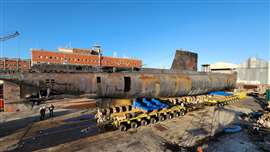 The historic SAS Assegaai, a former South African Navy submarine, in preparation for the trip to its new home in a museum. Photo: Vanguard
The historic SAS Assegaai, a former South African Navy submarine, in preparation for the trip to its new home in a museum. Photo: Vanguard
Relocating a 650 tonne submarine on land was a challenge exacerbated by appalling weather during the move.
Specialist contractor Vanguard battled heavy rain and gale force winds to get the SAS Assegaai, a former South African Navy submarine, to its new home. SAS Assegaai had to be transported 1.5 km from the Navy Dockyard to the new Naval Heritage site in Simons Town, South Africa.
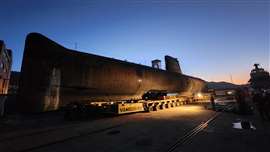 This 650 tonne submarine relocation project put Vanguard in the spotlight. Photo: Vanguard
This 650 tonne submarine relocation project put Vanguard in the spotlight. Photo: Vanguard
Vanguard engineered a solution to move the 58 metre long and 6 metre wide vessel using 34 axle lines of specialized trailer from Goldhofer. It had to be lifted, transported and then positioned on plinths for display.
Explaining the operation Bryan Hodgkinson, Vanguard director, said, “We had two 9 axle Goldhofer PST modules in the front and at the rear were two 8 axle THP/SL Goldhofer bogies. The trailers were all interlinked hydraulically, and the complete combination worked off one control console.”
Hodgkinson said all the steering was integrated, commenting that few companies have the internal expertise to set this up.
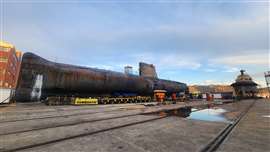 At the front was a pair of 9 axle Goldhofer PST modules, one each side, each with a power pack unit. Photo: Vanguard
At the front was a pair of 9 axle Goldhofer PST modules, one each side, each with a power pack unit. Photo: Vanguard
Getting underway
Prior to the first lift Navy Marine Architects did a lot of work to retain the structural integrity of the vessel during its loading, move and unloading.
The trailers’ hydraulic suspension was used to lift the submarine from the dockyard’s 4,000 tonne capacity synchro lift. Interesting in its own right, the synchro lift is a loading platform operated by 16 chain winches. It is used for lifting ships in and out of the water for repairs and maintenance work.
The submarine was sitting on a system of wooden marine chocks with the trailers positioned below under the saddles. The vessel was lifted using the trailer hydraulics and incrementally lowered until all the chocks were removed and the cradles sat directly on top of the trailer decks.
To hold the vessel on the trailers saddles were specially designed by the Navy Marine Architects and Vanguard’s engineering department. They were designed and fitted so that the trailers could be placed in position underneath them.
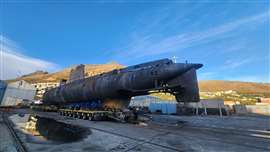 At the rear were two 8 axle THP/SL Goldhofer bogies, one each side and interlinked with the front two. Photo: Vanguard
At the rear were two 8 axle THP/SL Goldhofer bogies, one each side and interlinked with the front two. Photo: Vanguard
The saddles provided a secure fit to the hull of the ship and the cradles were lashed with chain and fixed steel stoppers to the trailers, Hodgkinson explained.
With the vessel loaded it could then make its way to the museum. The overall laden height of the load was 9.5 metres. Vanguard was responsible for clearing the route.
On arrival it was a case of positioning it over the premade plinths and lowering it into its final position.
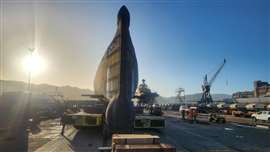 Front view showing the PPUs of the 9 axle modules each side of the submarine. Photo: Vanguard
Front view showing the PPUs of the 9 axle modules each side of the submarine. Photo: Vanguard
“This project was extremely interesting for the Vanguard team, not only for the engineering challenge that was presented, but also due to the history and heritage of the cargo being transported”, commented Andy Seleke, Vanguard field manager.
“Due to the nature of our work, we always build contingencies into every project we undertake, but the weather conditions are not something that we can control. The extreme weather conditions that we faced during the move created additional complexities, however the experience and diligence of the whole Vanguard team was evident and enabled the vessel to be delivered safely,” Seleke concluded.
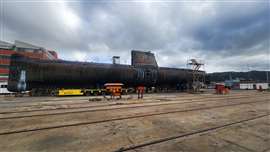 Photo: Vanguard
Photo: Vanguard
About the Assegaai Daphne Class submarine
Built for the South African Navy, SAS Assegaai, was commissioned on 21 August 1971 under the name SAS Johanna van der Merwe. It was involved in active service during the Angolan War of the 1980s before being renamed in 1999. It was decommissioned in 2003. Two of the three Daphne Class vessels built were cut up for scrap so this is the sole survivor, retained as a museum ship in Simons Town, South Africa.





